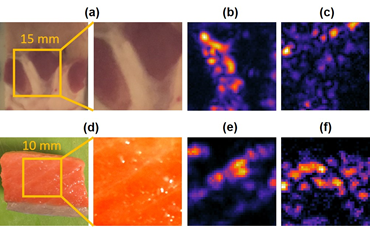Non-linear contrast for high resolution ultrasound imaging
Technology description
A fundamentally new method of ultrasound imaging that provide different contrast information as compared to the linear scattering of acoustic waves.
Researchers in Prof. Steven Chu’s laboratory have developed a fundamentally new method of acoustic imaging to improve resolution of ultrasound diagnostics. This system employs nonlinear difference frequency mixing, which provides different contrast information compared to conventional linear scattering of acoustic waves. The acoustic difference-frequency is generated when sound at two frequencies interacting in a non-linear medium. This information can then be used to create 2D or 3D images which could greatly improve medical diagnostics, particularly when visualizing cancer or cirrhosis.

Optical images of portions of pig kidney (a) and salmon (d), with the corresponding non-linear contrast (b) and (e) compared to linear contrast (c) and (f) ultrasound images. Application area
Ultrasound imaging- particularly in medical diagnostics for cancer and cirrhosis
Advantages
Improved resolution:new nonlinear contrast mechanism has 1.4x improvement in resolution compared to linear images sub-millimeter resolution at different frequencies

